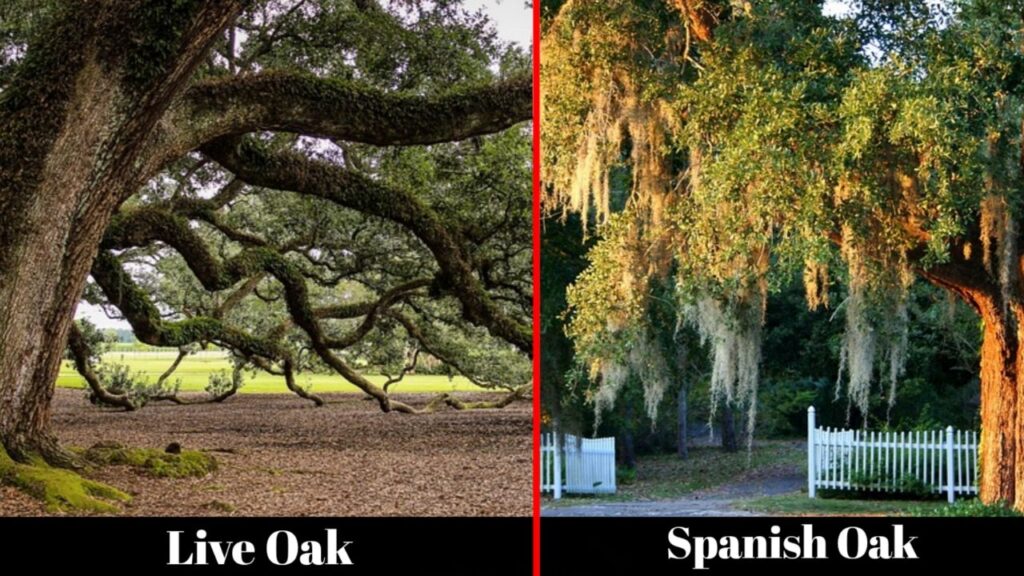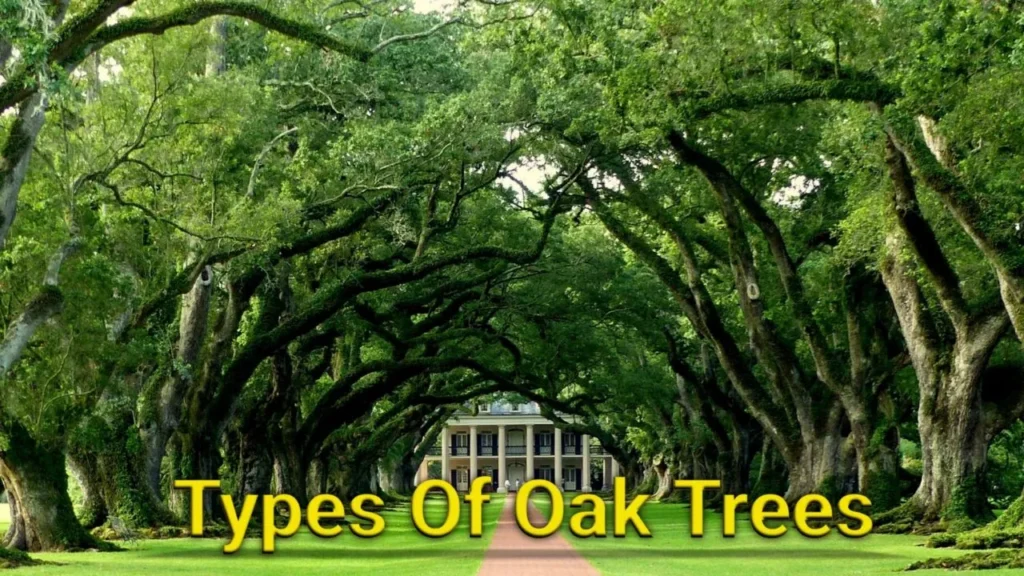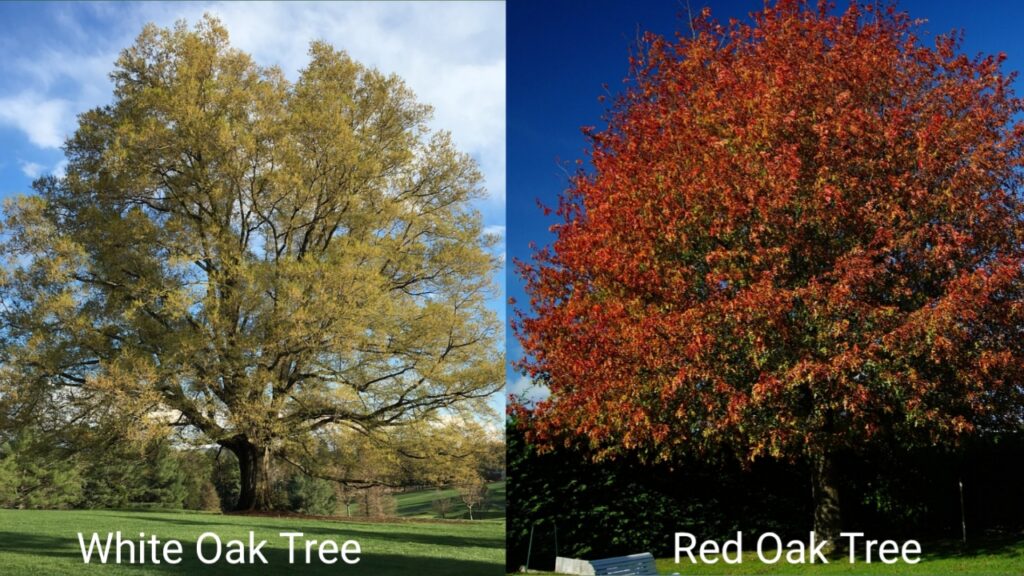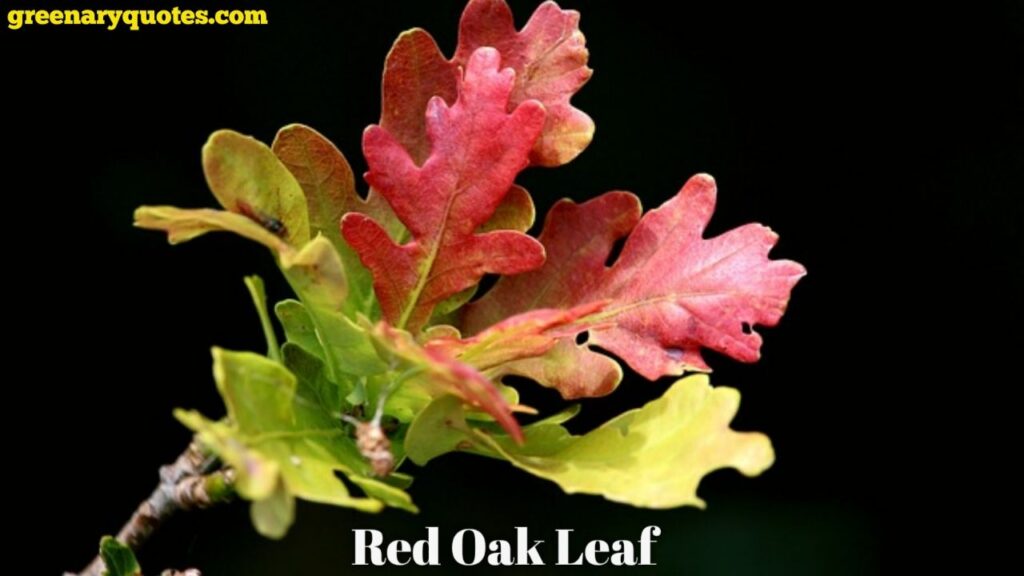Hello Everyone! Here I discussed about types of Oak trees name and a short introduction of each tree. Among the trees adored and recognized across the globe, oak trees stand out as some of the most iconic.
Thriving across forests worldwide, these majestic oak trees hold a crucial role in maintaining nature’s harmony. Acting as both providers of sustenance and safe havens for animals, their versatile timber serves a myriad of purposes.
Though there exist more than 600 types of oak trees, only a handful are commonly sighted in North America. Here is a simple guide to the 23 oak tree species most frequently seen in this region.
What Is Oak Tree ?
Oak trees are a very special kind of plants and our there are 500 types of oak trees around the world. These types of oak trees can actually live for more than 1000 years, although they typically stick around for about 200 years.
Oak trees that support a lot of different types of animals than any other kind of British tree. Basically they creating a little home for all sorts of life around them.
When it comes to wood, oak is pretty impressive. It is super strong tree. Many peoples use oak wood for building different kinds of things for thousands of years, They are still using it today.
Some countries and groups even think of oak trees as symbols of strength and wisdom. Take Ireland, for instance. They chose the sessile oak as their national tree. In Ireland, you’ll also find the sessile oak and the common oak.
Types Of Oak Trees
There are different types of oak trees. Here I discussed 23 oak types with their pictures and important points. Here you get full knowledge about these trees one by one.
1. White Oak
This oak tree is super popular in North America and you can find it all over the place. It’s pretty big, can reach heights of 100 feet, Its leaves are kind of lobed (that means they have little sections) and when it’s fall time, they turn shades like red, brown, and even purple.
People really like its wood – it’s used for things like making furniture, floors, and all sorts of wood stuff. Plus, it’s a fancy tree to have for looks, like a decoration for your yard. So, it’s a superstar in more ways than one!
| Common Name | White Oak |
| Scientific Name | Quercus alba |
| Mature Height | 70-100 feet |
| Hardiness Zone | 3-9 |
| Soil Requirements | Deep, well-drained soil |
| Sun Requirements | Full sun |
| Soil PH | Acidic to neutral |
| Place | Eastern and central North America |
Important Points
- Oak wood is tough and long-lasting, perfect for making furniture, floors, and lots of wood stuff.
- Animals love munching on acorns, those little oak nuts that fall from the trees.
2. Red Oak
Here’s another familiar oak tree you’ll find across North America. It looks a lot like the white oak, but its leaves are usually bigger and come with more pointy sections. Many Peoples also appreciate the red oak because of its wood. However, it’s not as strong as the white oak.
Red oaks can grow quite tall, providing shade for picnics and cozy spots for animals. Transforming the landscape into a breathtaking autumn canvas. The big role of this types of oak trees is it maintains soil health.
| Common Name | Red Oak |
| Scientific Name | Quercus rubra |
| Mature Height | 60-100 feet |
| Hardiness Zone | 3-9 |
| Soil Requirements | Deep, well-drained soil |
| Sun Requirements | Full sun |
| Soil PH | Acidic to neutral |
| Place | Eastern and central North America |
Important Points
- Sturdy oak wood creates durable furniture, flooring, and a range of wooden items due to its toughness and long-lasting nature.
- The leaves turn a beautiful red color in the fall.
3. Bur Oak

Its bark, like a cozy shield, is thick and corky, providing protection from both fire and pesky critters. Now, here’s the scoop: while the bur oak’s timber is quite prized, it’s not in the limelight as much as the popular white oak or red oak.
In maturity it reached up to 120 feet height. This tree is looks a like a nature guard because it helps different types of animals by the branches. It also play a role in feeding different animals, for this reason it become a nature’s superhero.
| Common Name | Bur Oak |
| Scientific Name | Quercus macrocarpa |
| Mature Height | 80-120 feet |
| Hardiness Zone | 3-9 |
| Soil Requirements | Deep, well-drained soil |
| Sun Requirements | Full sun |
| Soil PH | Acidic to neutral |
| Place | Eastern and central North America |
Important Points
- Sturdy oak wood creates durable furniture, flooring, and a range of wooden items due to its toughness and long-lasting nature.
- The outer layer of the tree, called bark, is tough and spongy. It keeps the tree safe from things like fire and bugs.
4. Chinkapin Oak
Let’s get to know the charming chinkapin oak – a deciduous tree, not too big, around 50 feet tall. When fall rolls in, its leaves change into warm colors, making a beautiful sight.
This oak tree is not just have a cute face,
Its acorns aren’t your regular kind; they’re like yummy snacks for animals, giving them a healthy meal.
These type of oak trees do a great job in the forest because they feeds lots of animals and also helping the whole ecosystem.
| Common Name | Chinkapin Oak |
| Scientific Name | Quercus muehlenbergii |
| Mature Height | 40-50 feet |
| Hardiness Zone | 4-8 |
| Soil Requirements | Deep, well-drained soil |
| Sun Requirements | Full sun |
| Soil PH | Acidic to neutral |
| Place | Eastern North America |
Important Points
- Animals love munching on acorns – they’re like tasty snacks from the oak tree’s menu!
- The leaves turn a beautiful brown or yellow color in the fall.

5. Live Oak
The live oak tree is a hard tree that can survive for a long times. These leaves can hold water in it, so that is the cause it can survive in hot and dry climates. This is the longest oak tree I think so! Live oaks tree are also known for spreading branches.
Their salt spray ability makes it popular ornamental tree all over the coastal areas.
But don’t let their ancient wisdom fool you: they’re still a little bit silly. Just ask any squirrel who’s tried to climb one!
| Common Name | Live Oak |
| Scientific Name | Quercus virginiana |
| Mature Height | 50-100 feet |
| Hardiness Zone | 6-11 |
| Soil Requirements | Deep, well-drained soil |
| Sun Requirements | Full sun |
| Soil PH | Acidic to neutral |
| Place | Southeastern United States |
6. Spanish Oak
The Spanish Oak tree is a small oak tree but it is a evergreen, it can grow up to maximum 30 feet tall. Their leaves are spiny, it help to protect the oak tree from some kind of animals like browsing animals.
It’s said that the Spanish oak got its name because its sharp leaves can make a person yelp in pain if they brush against them. But don’t let its prickly exterior fool you – the Spanish oak is a hardy and beautiful tree that can add a touch of elegance to any landscape.
| Common Name | Spanish Oak |
| Scientific Name | Quercus ilex |
| Mature Height | 30-40 feet |
| Hardiness Zone | 7-10 |
| Soil Requirements | Well-drained soil |
| Sun Requirements | Full sun |
| Soil PH | Acidic to neutral |
| Place | Mediterranean region |
7. Swamp White Oak
This tree is defferent types of oak trees. The swamp white oak tree grow in medium size. This tree can grow up to maximum 60 feet tall. Its lobed leaves turn yellow or brown in the fall.
Swamp white oak is also known for their it’s strong timber. It is patients of wet soil, so that’s mean it is a good choice for planting these types of oak trees near ponds. Be careful ! This tree can be a bit aggressive and may take over your yard if you’re not careful.
| Common Name | Swamp White Oak |
| Scientific Name | Quercus bicolor |
| Mature Height | 60-70 feet |
| Hardiness Zone | 4-9 |
| Soil Requirements | Wet, well-drained soil |
| Sun Requirements | Full sun to partial shade |
| Soil PH | Acidic to neutral |
| Place | Eastern North America |
8. Overcup Oak
The overcup oak is a white types of oak trees that stands out with its light brown to tan acorns, shiny green leaves with deep cuts, and dark gray bark that looks all wrinkly. When you see it in a yard, you’ll notice it has a round crown on top. These trees can grow up between 45 and 70 feet tall and spread out about 45 feet wide.
The leaves of the overcup oak are shaped like wedges and have edges that look like they’ve been cut into lobes. They’re about 6 to 8 inches long, glossy on top, and kind of fuzzy gray underneath. In the fall, the leaves turn a coppery-brown or deep red color.
| Common Name | Overcup Oak |
| Scientific Name | Quercus lyrata |
| Mature Height | 60-70 feet |
| Hardiness Zone | 4-9 |
| Soil Requirements | Wet, well-drained soil |
| Sun Requirements | Full sun to partial shade |
| Soil PH | Acidic to neutral |
| Place | Eastern North America |
Important Points
- What’s interesting about the overcup oak is its acorns – they have these bumpy caps that nearly cover the whole nut.
- These nuts are about 0.5 to 1 inch long and are the reason for the oak’s name.
9. Post Oak
The post oak tree is a sturdy tree it is also known for its strong wood. Its leaves are shaped like a cross and turn red in fall. With a rounded crown, it grows about 40 to 50 feet tall. It’s common in the eastern US and is liked for shade.
| Common Name | Post Oak |
| Scientific Name | Quercus stellata |
| Mature Height | 30-40 feet |
| Hardiness Zone | 5-9 |
| Soil Requirements | Deep, well-drained soil |
| Sun Requirements | Full sun |
| Soil PH | Acidic to neutral |
| Place | Eastern North America |
Important Points
- The wood is very strong and durable for long years and is used for furniture, flooring, and other types of wood products.
- The tree doesn’t mind if the soil is a bit lackluster – it’s like the chill friend who’s up for an adventure no matter where you go! Poor soils? No problem!
10. Pin Oak

Pin Oak tree is a tall tree and handsome tree. it also known for its distinctive shape and leaves that look like pins. So that is the main cause it calls pin Oak tree. These leaves are pointed at the ends and have deep cuts.
Pink Oak tree’s branches are very strong, and it is normally seen in parks or streets. In the fall season it’s leaves colour change into reddish or brown color and it add a beautiful looks to the scenery.
| Common Name | Pin Oak |
| Scientific Name | Quercus palustris |
| Mature Height | 50-70 feet |
| Hardiness Zone | 3-9 |
| Soil Requirements | Wet, well-drained soil |
| Sun Requirements | Full sun to partial shade |
| Soil PH | Acidic to neutral |
| Place | Eastern North America |
Important Points
- The tree is very tolerant of wet soils and making it a best choice for planting near streams or ponds.
- The leaves turn a beautiful red, brown, or purple color in the fall.
11. Black Oak
Black oak, a remarkable tree, is easily recognized by its dark bark and deeply lobed leaves. In the summer season, it have glossy green leaves that provide cool shade. When autumn season arrives, they transform into rich colors of red and orange, painting the landscape with vibrant colors.
Black oak tree can grow up to 80 feet tall, the black oak stands with a rugged charm. Black oak wood is used for different purposes, from furniture to barrels.
| Common Name | Black Oak |
| Scientific Name | Quercus velutina |
| Mature Height | 60-80 feet |
| Hardiness Zone | 3-9 |
| Soil Requirements | Deep, well-drained soil |
| Sun Requirements | Full sun |
| Soil PH | Acidic to neutral |
| Place | Eastern North America |
12. Chestnut Oak
Let’s talk about the Chestnut Oak – a strong and sturdy tree that’s quite remarkable. This tree get its name from its leaves that look like chestnut tree leaves. You can spot this oak by its big, toothy leaves that grow about 4 to 7 inches long.
They’re glossy on top and pale underneath. This oak’s bark is scaly and kind of dark. It is good for wildlife animals! Birds and animals love its acorns, which are about 1 inch long. This tree can grow around 50 to 70 feets.
| Common Name | Chestnut Oak |
| Scientific Name | Quercus prinus |
| Mature Height | 50-70 feet |
| Hardiness Zone | 4-8 |
| Soil Requirements | Deep, well-drained soil |
| Sun Requirements | Full sun |
| Soil PH | Acidic to neutral |
| Place | Eastern North America |
13. Eastern Black Oak
The Eastern Black Oak, a native forest dweller, boasts dark, rugged bark and shiny, green leaves with wavy edges. In fall season, Eastern Black Oak leaves turn into a unbelievable palette of red, orange, and gold.
This tree growing up to 80 feet tall, it’s a grand presence in woodlands. Its acorns are like little treasures, usually bunched together, and wildlife loves them.
It is a true guard of nature, It offering shelter and food to big and small creatures, while painting the autumn woods with its fiery hues.
| Common Name | Eastern Black Oak |
| Scientific Name | Quercus velutina nigra |
| Mature Height | 70-80 feet |
| Hardiness Zone | 3-9 |
| Soil Requirements | Deep, well-drained soil |
| Sun Requirements | Full sun |
| Soil PH | Acidic to neutral |
| Place | Eastern North America |
14. Northern Red Oak
The Northern Red Oak is a different type of trees like striking trees and it is known for its strength and different autumn season display. With leaves that turn fiery shades of red, orange, and bronze in the fall, it’s like a living fireworks show.
These type of oak trees can grow up to 90 feet in height and they spreading their branches wide.
Their leaves have pointed lobes and can be about 5 to 9 inches long.
| Common Name | Northern Red Oak |
| Scientific Name | Quercus rubra × velutina |
| Mature Height | 60-80 feet |
| Hardiness Zone | 3-9 |
| Soil Requirements | Deep, well-drained soil |
| Sun Requirements | Full sun |
| Soil PH | Acidic to neutral |
| Place | Northeastern United States |
15. Gambel Oak
Gambel Oak, a hardy shrub-like tree, is a friend to arid landscapes. Sporting its resilient foliage and tiny acorns, offers shelter and foods for animals.
These types of oak trees will only spot in dry places and these trees looks like a nature superhero and they provide this facilities for both environment and animals.
| Common Name | Gambel Oak |
| Scientific Name | Quercus Gambelii |
| Mature Height | 20-30 feet |
| Hardiness Zone | 3-9 |
| Soil Requirements | Wet, well-drained soil |
| Sun Requirements | Full sun |
| Soil PH | Acidic to neutral |
| Place | Western United States |
16. Scarlet Oak
In the realm of splendid trees, the scarlet oak stands regal and tall. Its glossy, serrated leaves, tinged with a scarlet hue in autumn, add a breathtaking charm. The bark, gray-brown in nature, carries an unmistakable trait – V-shaped markings on its branches.
Gardens and Parks find joy because of this oak tree, especially during its stunning fall season spectacle.
This tree can grow up to 80 feet in height and this oak tree offers ample shade, thanks to its generously spreading branches. Despite its small size, the acorns it produces are treasured by wildlife.
| Common Name | Scarlet Oak |
| Scientific Name | Quercus coccinea |
| Mature Height | 50-60 feet |
| Hardiness Zone | 4-9 |
| Soil Requirements | Deep, well-drained soil |
| Sun Requirements | Full sun |
| Soil PH | Acidic to neutral |
| Place | Eastern North America |
17. Savannah Oak
This tree looks very attractive like a some kind of majestic things. This is different types of oak trees because They commonly appear in the United States.
Scaling heights of up to 80 feet and boasting an impressive branch spread, it commands admiration. Its leaves, adorned with a glossy sheen, maintain their verdant hue throughout the year.
| Common Name | Savannah Oak |
| Scientific Name | Quercus margaretta |
| Mature Height | 30-40 feet |
| Hardiness Zone | 6-9 |
| Soil Requirements | Deep, well-drained soil |
| Sun Requirements | Full sun |
| Soil PH | Acidic to neutral |
| Place | Southeastern United States |
18. Shin Oak
Shin oak, a petite yet tough character, thrives in challenging terrains. Its small, wavy leaves earned it the “shin” name, as if they’re winking playfully in the breeze.
This types of oak trees can grow up to about 30 to 60 feet long and they creating cozy nooks for critters.
In spring season, it blooms with very small flowers and making the landscape looks perfect.
| Common Name | Shin Oak |
| Scientific Name | Quercus imbricaria |
| Mature Height | 50-60 feet |
| Hardiness Zone | 4-9 |
| Soil Requirements | Deep, well-drained soil |
| Sun Requirements | Full sun |
| Soil PH | Acidic to neutral |
| Place | Eastern North America |
19. Water Oak

These types of oak trees normally grow around in ponds and rivers. Recognizable by its petite, slender leaves sporting rounded edges and a glossy upper surface, it undergoes a transformative shift in fall, transitioning from vibrant green to reddish-brown.
This tree also small with spherical acorns and cherished by a range of creatures including squirrels.
Reaching heights of about 60 to 80 feet, water oaks boast wide-spreading branches. When near a waterway, take a moment to acquaint yourself with these affable trees that share a fondness for aquatic environments!
| Common Name | Water Oak |
| Scientific Name | Quercus nigra |
| Mature Height | 60-80 feet |
| Hardiness Zone | 4-9 |
| Soil Requirements | Wet, well-drained soil |
| Sun Requirements | Full sun to partial shade |
| Soil PH | Acidic to neutral |
| Place | Southeastern United States |
20. Willow Oak
This tree can grow up to 100 feet in height, it is a towering presence in forests.
Sporting a light gray bark, it graces parks and streets as a popular shade provider. Producing dainty half-inch acorns, it’s a treat for critters. Willow oaks, akin to natural skyscrapers, offer both refuge and shade with pride.
| Common Name | Willow Oak |
| Scientific Name | Quercus phellos |
| Mature Height | 50-60 feet |
| Hardiness Zone | 3-9 |
| Soil Requirements | Wet, well-drained soil |
| Sun Requirements | Full sun to partial shade |
| Soil PH | Acidic to neutral |
| Place | Southeastern United States |
21. Basket Oak
These types of oak trees can grow around 60 to 80 feet high, and their leaves have a fun shape – they look like baskets with wavy edges.
These leaves are around 4 to 8 inches long and have a greenish color. You can often spot them turning a lovely yellow in the fall, adding a touch of autumn magic.
| Common Name | Basket Oak |
| Scientific Name | Quercus michauxii |
| Mature Height | 30-40 feet |
| Hardiness Zone | 5-9 |
| Soil Requirements | Deep, well-drained soil |
| Sun Requirements | Full sun |
| Soil PH | Acidic to neutral |
| Place | Southeastern United States |
22. Diamond Oak
Diamond Oak represents a flooring option crafted from oak tree heartwood. This types of oak trees looks like a diamond oak. Imagine a tree that wears leaves shaped like diamonds – that’s the Diamond Oak! With a playful wink at symmetry, these leaves stand out like nature’s own bling.
Native to various places, this oak isn’t just a style icon – it’s a home for critters too! Its glossy green leaves, partying on top and cool below, switch to fiery red and orange for a grand fall fashion show.
Decked out in diamond leaves and autumn’s finest hues, the Diamond Oak shines as a nature’s gem, ready to steal the show!
| Common Name | Diamond Oak |
| Scientific Name | Quercus laevis |
| Mature Height | 30-40 feet |
| Hardiness Zone | 6-9 |
| Soil Requirements | Deep, well-drained soil |
| Sun Requirements | Full sun |
| Soil PH | Acidic to neutral |
| Place | Southeastern United States |
23. Laurel Oak
The Laurel Oak tree is different types of oak trees because it is distinctive tree.
Its leafy crown and glossy, movie-star leaves, it’s like the A-lister of the oak world. Its name might remind you of fancy spices, but it’s all about the stunning leaves.
These leaves are so shiny, you can almost use them as mirrors! And when fall arrives, they put on a fiery show, turning shades of red and orange that make other trees jealous.
| Common Name | Laurel Oak |
| Scientific Name | Quercus hemisphaerica |
| Mature Height | 30-40 feet |
| Hardiness Zone | 8-11 |
| Soil Requirements | Deep, well-drained soil |
| Sun Requirements | Full sun |
| Soil PH | Acidic to neutral |
| Place | Southeastern United States |
FAQs –
What are the different types of oak trees in North America?
There are several oak tree species in North America, including the white oak, red oak, black oak, and more.
How can I identify different types of oak trees by their leaves?
Oak tree leaves can vary, but you can often identify them by their lobed or serrated edges and distinctive veining patterns.
Which types of oak trees are suitable for landscaping in my region?
The best oak tree for landscaping depends on your location. Local nurseries or gardening experts can provide guidance on the most suitable species.
Are there rare or endangered types of oak trees?
Yes, some oak tree species, like the Quercus robur (English oak), are considered threatened or endangered in certain regions due to habitat loss.
What types of oak trees produce acorns that are safe for wildlife and human consumption?
Generally, most oak tree acorns are safe for wildlife, but some species like the “live oaks” (e.g., Quercus virginiana) produce larger acorns that are often preferred by wildlife and can be consumed by humans after proper preparation.



